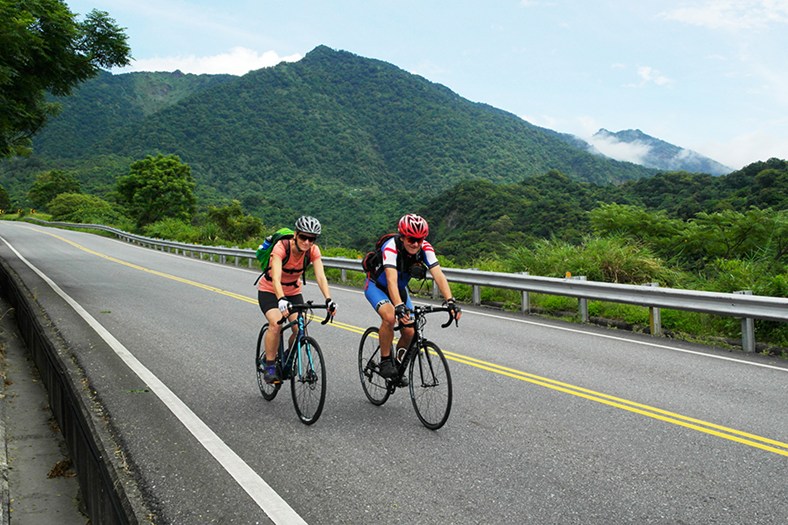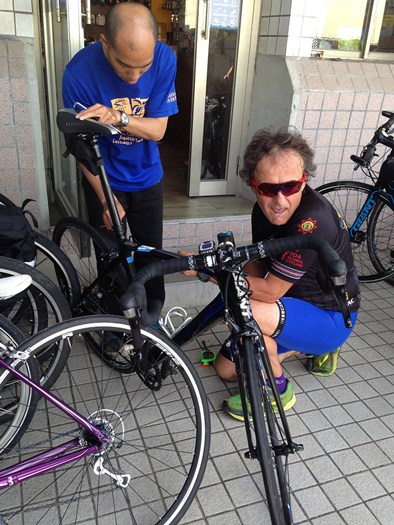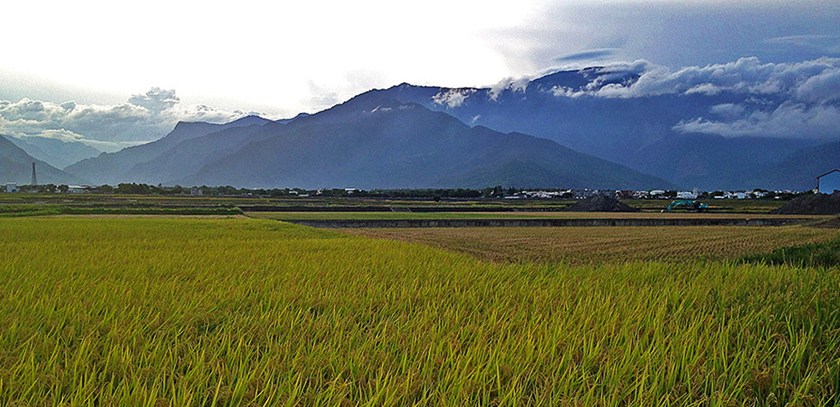TAITUNG, TAIWAN - We had only five kilometres left to cycle that day, but it was hot, our muscles were complaining and the long road ahead of us sloped upwards, reminding us that we’d have to work that much harder to get to our final destination.
As we approached the hill in the Taiwanese countryside, we came to a small community of homes. By the roadside, in the merciful shade of a towering tree, was a small Taoist shrine, one of many similar structures found throughout the country.
The small red building, no bigger than a garden shed, was adorned with colourful sculptures of Chinese gods and monsters. Inside was a golden statue of a deity with offerings left behind by worshippers from nearby farms. We didn’t have anything to offer, but we thirstily drank our remaining water and silently beseeched any gods that were listening to provide us with the energy needed to climb that final hill.

Above: Taiwan offers cyclists lots of eye candy thanks to its mountains and lush tropical setting.
Our prayers were answered because, in what seemed like no time, we powered up the slope ahead and coasted the rest of the way to the hotel where the others in our group were waiting. We were able to luxuriate in the pool where our aching muscles could recover for the next day’s ride.
We had come to the island nation of Taiwan to explore it by bicycle and soon discovered that this mode of transportation was the perfect way to experience this beautiful Asian destination. The slow pace allowed us to savour the sights in a way that would be impossible if we were hurtling by in the metal and glass of a car.
Cycling in Taiwan is easy. The country has a well-established cycling culture and there are numerous official routes dedicated to two-wheeled travellers, including Cycling Route No. 1, a 1,200-kilometre itinerary that circumnavigates the entire island. These cycling routes consist of dedicated lanes on the side of smoothly-paved highways that are so well-maintained that they seem like they were built just last week.


Above: Cities are easy and safe to navigate on a bike and in rural Taiwan cyclists get lots of help.
Our journey began in Taiwan’s East Rift Valley, a beautiful, flat region that lies between the Central Mountains to the west and the Coastal Mountains to the east. It is the country’s rice bowl and we cycled from Taitung to Chishang past endless rice fields that lay nestled between the mountains on either side of us. It was harvest time so the fields were a golden yellow, but in spring they are a lush green.
Along the route, we discovered that every 20 kilometres or so there are bicycle service stations, usually housed within local police stations. They provide water, air pumps and assistance to those who need it.
Every town along the route also seems to have a 7-Eleven. The American convenience stores are ubiquitous and are often the de-facto service station for passing cyclists who come to rest and fuel up for the next segment of their ride. They also serve as a meeting place for cyclists and you will find many Taiwanese riders who are more than delighted to help foreigners on their journey.
After spending time in the Rift Valley, we headed east to the coast. Here, the highway follows the shore and is flanked to the west by the Coastal Mountains. These high, cloud-topped peaks are blanketed with greenery and slope steeply toward the sea. As pretty as the Rift Valley was, this scenery was even more spectacular and we didn’t even mind the extra hills.

Above: The rolling farm land of Taiwan and its mountain backdrop make it one of Asia's loveliest countries.
The cycling tradition in Taiwan starts with Giant, which is definitely a giant in the cycling industry. The Taiwanese company is the world’s largest manufacturer of bicycles and plenty of them are sold here. Chances are any bike you rent for your tour of the country will be a Giant. We rode rented Giants and, apart from a few minor technical problems that were easily remedied en route, they served us well.
Anyone contemplating a cycling trip to Taiwan can hook up with any one of a number of local tour operators that will customize tours for them. These outfits will typically arrange bike and helmet rentals, book hotels and restaurants and provide support vans to transport luggage and offer technical support. If you’re more of a do-it-yourselfer that likes to organize things on your own, then you could easily make all of the arrangements for yourself online.
The coastal segment of our ride ended in Hualian, a small city that offers many of the attractions that are common staples in other Taiwanese cities but in a more compact form, such as a night market that will overload your senses and a mouth-watering selection of restaurants. Because Taiwan was populated by an influx of people from every corner of China after the Chinese Civil War, and then lived under Japanese rule for 50 years, as well as being home to a variety of indigenous peoples, the country has an exciting food culture unique in Asia.
From Hulian, we ventured to nearby Taroko National Park, a gorgeous wild area that straddles the Coastal Mountains. It is the home of Taroko Gorge, a soaring canyon of rock that cuts through the mountains. The road that runs through the park is also the route for King of the Mountain, an annual cycling road race that challenges riders from near and far. KOM takes racers along a gruelling 105-kilometre route of switchbacks that start at sea level and end in the thin air of the finish line at 3,275 metres.
Two of the fitter riders in our group rode part of the route while the rest of us enjoyed the scenery from the comfort of the van. The sturdy duo reported to the rest of us that the ride was challenging, but fun. They were sweating at the end, but smiling, so I will have to take their word for it.
Our trip ended at Sun Moon Lake, an idyllic resort area in the centre of the country that was a favourite of Chiang Kai-shek, the founder of modern Taiwan.
On the final morning, we got up just after dawn to avoid the midday heat and crowds and cycled our way along the 33-kilometre route that circles the lake.
Along the way, we stopped at temples and scenic lookouts and paused to watch a family of monkeys crash through the bamboo forest. Birds were singing as we rode by and cicadas buzzed noisily. It was paradise and before we knew it, the ride was over. Our bikes were packed away and we had to return to the airport in the glass and metal cage of the van where we could no longer feel, smell the fragrant fields going by or hear the sounds of the people around us.
Taiwan is definitely best experienced on two wheels.
Information
These local tour operators can organize cycling trips in Taiwan: Giant Adventure (
www.giantcyclingworld.com/travel) Tour operator specializing in cycling trips for those who want to join a group or have a customized trip. / Formosa Lohas Cycling Association: (
biketour.flca.tw/en/) Another tour operator that offers route information and packages. / For general information about recommended cycling routes, try these sites: Cycling Around Taiwan:
map.taiwan.net.tw/ebook/CyclingAroundTaiwanEnglish2014.pdf / Kaohsiung City:
khh.travel/Article.aspx?a=7008&l=2 / New Taipei City:
tour.ntpc.gov.tw/page.aspx?wtp=3&wnd=336&town=&kw=cycling / Other cycling events in Taiwan: Taiwan Cycle Festival:
taiwanbike.tw/default.aspx?lang=2 Although it is called festival, this website includes news and other information about four popular cycling competitions in Taiwan, including KOM, Formosa 900, OK Taiwan, and Cycling festival. There is also useful information for cycling tips and routes. / Tour de Taiwan:
www.tourdetaiwan.org.tw/index.aspx Tour de Taiwan is an annual professional road racing stage race held in Taiwan since 1978 and is part of the UCI Asia Tour since 2005. / KOM:
www.taiwankom.org/en/ KOM (The King of The Mountain) is another popular international cycling race in Taiwan that is held every September. / Eva Airlines (from Toronto) and China Airlines (from Vancouver) offer flights to Taiwan. / Taitung was recently named one of Lonely Planet’s top Asian destinations.
About the Author
"Montreal-based travel journalist Mark Stachiew has been travelling the world and writing about it for more than 25 years. Formerly the Travel Editor for Postmedia Network’s canada.com, his writing and photography have appeared in numerous newspapers, websites and magazines. He has loved to travel ever since his parents took him on epic cross-country road trips as a child. Mark believes travel can be a force for good and hopes his stories inspire others to explore the world to encounter different cultures in order to gain a greater understanding of how we are all connected.".